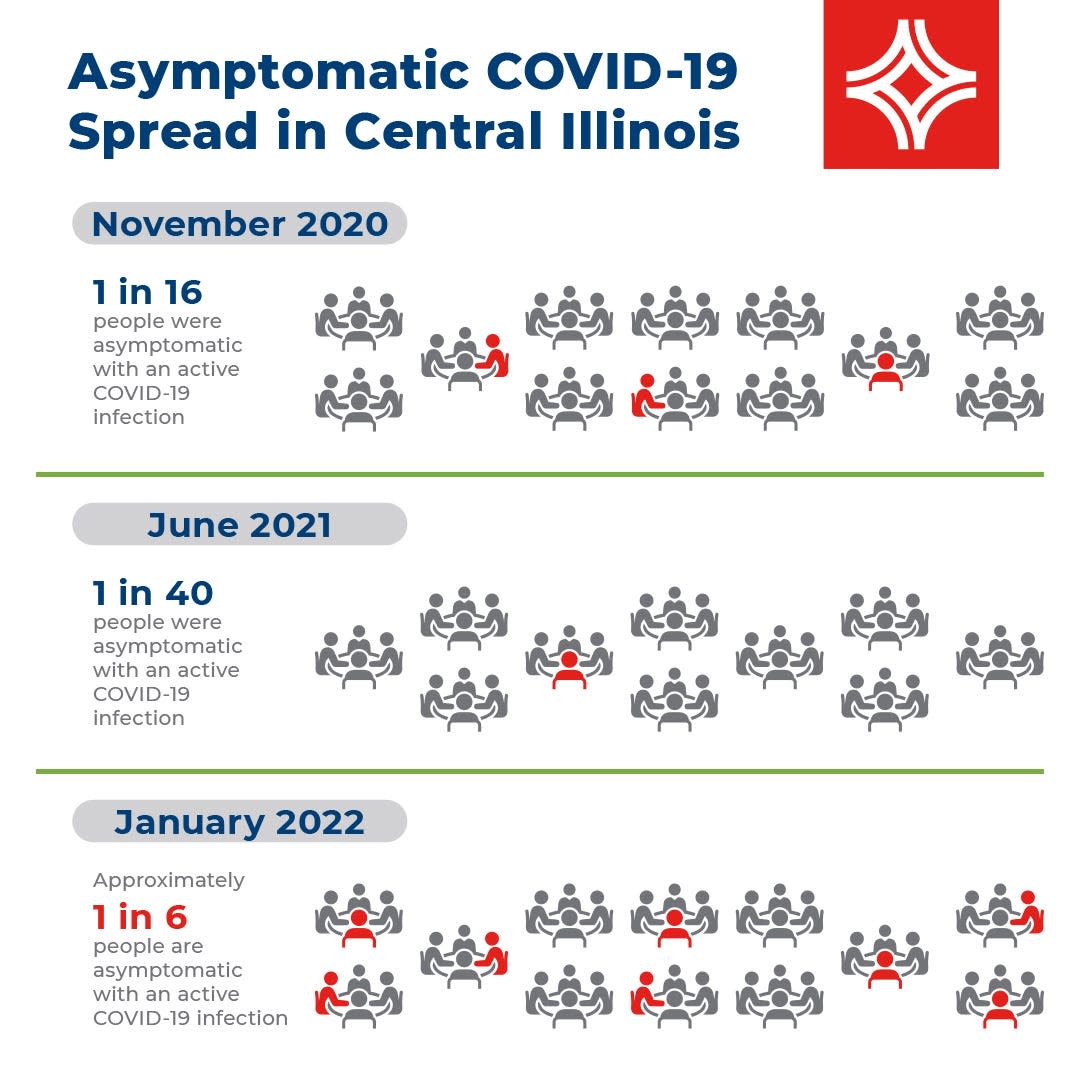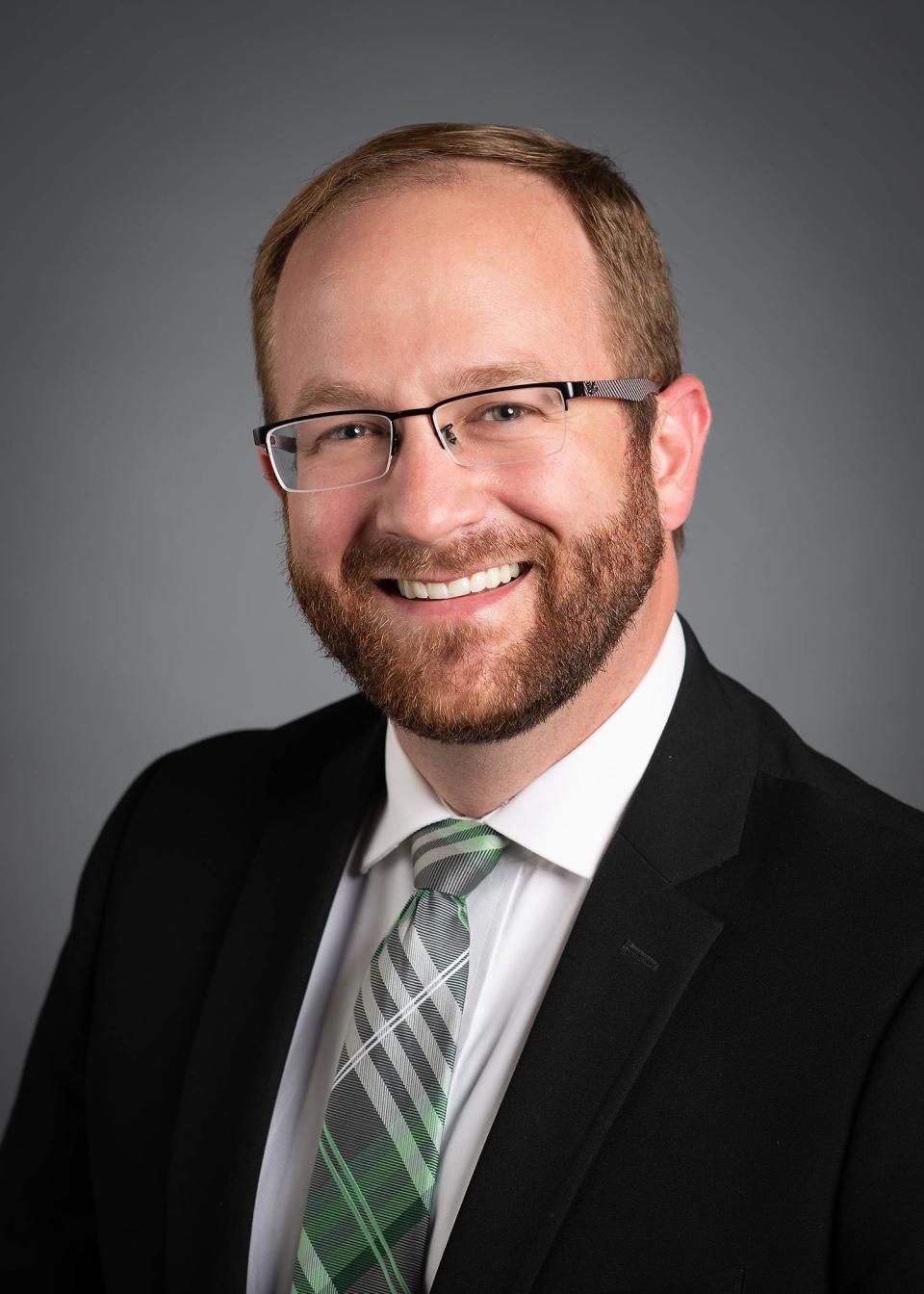'More people are sick': Memorial Health chart shows how pandemic isn't slowing down

- Oops!Something went wrong.Please try again later.
A chart that shows a growing number of people unaware they have COVID-19 sitting right next to uninfected people and potentially transmitting the virus is Memorial Health’s attempt to turn math into motivation.
The eye-catching chart, being publicized on social media by the Springfield-based health system, depicts people sitting around tables to demonstrate the prevalence of central Illinois residents with asymptomatic COVID-19 rising to its highest-ever level in January.
Based on Memorial’s analysis, one in 16 people in central Illinois had COVID-19 with no symptoms in November 2020. That prevalence dropped to one in 40 in June 2021 but shot up this month to one in every six.
The chart dispels the notion that the pandemic isn’t getting worse, according to Dr. Rajesh Govindaiah, Memorial Health’s senior vice president and chief physician executive.
More: Pritzker says tools to defeat COVID available as Sangamon County reports two new deaths
Some COVID-19 pandemic skeptics may believe rising case numbers simply are a function of more people being tested, but Govindaiah disagreed.
“More people are sick,” he said.
Moreover, a bigger slice of the population now has asymptomatic COVID-19, he said. That means people can easily and unknowingly transmit coronavirus disease, especially the omicron variant, to people with chronic health conditions and others more likely to develop serious complications, he said.
Hospitals see the situation first-hand as they fill up with COVID-19 patients, Govindaiah said.
Memorial Health, which operates five hospitals in central Illinois, is caring for near-record numbers of COVID-19 patients — 168 at last count. The number compares with the system’s latest record of 184 COVID-19 patients on Jan. 7.
Most of Memorial Health’s COVID-19 patients are unvaccinated or without recommended booster shots, Govindaiah said.
It’s more important than ever for people to get their primary round of vaccinations, and booster shots if they are eligible, he said, adding that everyone, regardless of vaccination status, should wear masks in public and avoid largely unmasked crowds.
“The amount of COVID activity in our community is at an unprecedented, all-time high,” Govindaiah said. “And every step you take adds a layer of protection.
“At this point in the pandemic, I don’t think there’s a person out there who wants to sit with a mask and get vaccinated and not leave their house,” he said. “The more things you do to stay safe and avoid risky areas, the safer you’re going to be.”

To create the chart, not-for-profit Memorial Health relied on data from its flagship institution, Springfield Memorial Hospital.
The 500-bed Springfield hospital requires patients undergoing non-emergency surgical procedures such as gallbladder removals, tonsillectomies, colonoscopies and knee replacements to take a COVID-19 test beforehand.
Patients are told to not even get tested and postpone their procedures if they are exhibiting symptoms of COVID-19, Govindaiah said. The procedures also are postponed when there’s a positive COVID-19 test.
The patients are generally healthy and generally representative of central Illinois’ population, Memorial officials said. About half of the patients live in Sangamon County, and the other half live within a radius of 50 to 75 miles, in 15 surrounding counties, officials said.
In November 2020, at a time when COVID-19 cases were surging and deaths eventually posted all-time high numbers locally, 6.25% of Memorial’s non-emergency surgical patients, or one in 16, were testing positive for COVID-19.
The chart reflects the positive patients during this period as three red-tinted figures sitting at three different tables in a cluster of 12 tables, with four people seated at each table.
More: Republicans call for hearings into DCFS after deaths of Springfield investigator, child
In June 2021, when Memorial’s test-positivity rate was 2.5%, one figure was tinted red among 40 people at 10 tables.
By January 2022, the positivity rate had jumped almost sevenfold, to 16.6%, or one in six — a prevalence represented by eight red-tinted figures among 48 people at 12 tables.
“This figure represents a new high-water mark for COVID-19’s spread among people who are free of symptoms,” said Lance Millburg, Memorial Health’s system administrator for quality and performance improvement. “Our research underscores how rapidly the omicron variant is dispersing through our community.”

The chart was designed to make statistics relatable, Millburg said.
Govindaiah added: “No one would willingly spread a potentially deadly virus to their loved ones. Yet that’s what some symptom-free people are doing — at an alarming rate — when they carry the COVID-19 virus and don’t regularly wear masks and practice social distancing.
The latest omicron-fueled surge began after October saw the Springfield Memorial surgical patients’ COVID-19 test-positivity rate drop to 1%.
Stopping the spread of omicron may not be realistic, but slowing the spread is critical, Govindaiah said. Research is clear that vaccinations, masks and other precautions slow the spread, he said.
“The goal is to prevent COVID from causing such a high number of infections that critical infrastructure is not able to function,” he said. “It’s the ability to send our kids to school. It’s the ability of police and fire departments to operate. It’s the ability for the health care system to operate.
“And if everyone gets sick at the same time, that would be like everyone taking every car they own and driving it on the interstate at the same time. It won’t work.”
Editor's note: An earlier version of this story listed two incorrect dates for COVID-19 test-positivity rates among non-emergency surgical patients at Springfield Memorial Hospital.
Contact Dean Olsen: dolsen@gannett.com; (217) 836-1068; twitter.com/DeanOlsenSJR.
This article originally appeared on State Journal-Register: Memorial Health in Illinois: 1 in 6 people have COVID but no symptoms
